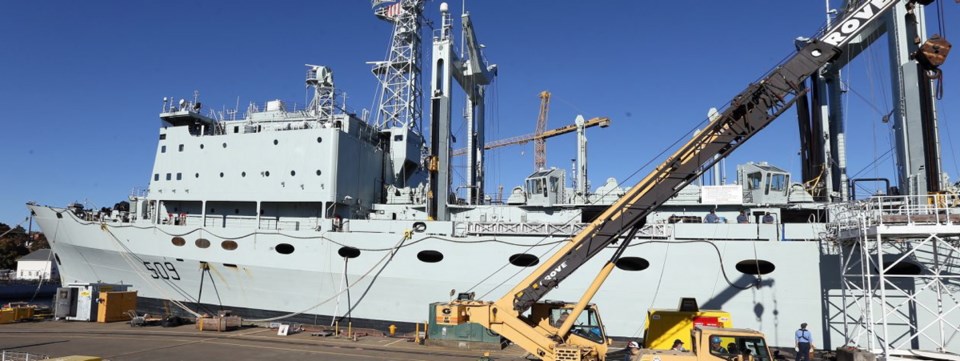HMCS Algonquin and HMCS Protecteur, which collided during exercises at sea last year on the way to Hawaii, are being retired, along with two other ships, the navy announced Friday.
The four ships have reached the end of their operational lives, said Vice Admiral Mark Norman, commander of the Royal Canadian Navy.
Protecteur, also damaged by fire, and Algonquin are based at CFB Esquimalt. Halifax is home port for the other two ships, HMCS Iroquois and HMCS Preserver.
“All of the ships are at or approaching the end of their effective and productive service lives and any further expenditure of time or money in these ships no longer makes sense,” Norman said.
Algonquin and Iroquois are destroyers. Protecteur and Preserver are supply vessels.
Norman said the retirements have been in the cards for some time, but the collision and fire sped up the decision to mothball the vessels.
When it collided with Protecteur in August 2013, Algonquin ended up with extensive damage to its port-side hangar.
In February, Protecteur suffered a major engine room fire and had to be towed home from Hawaii.
Inquiries are underway into both the collision and the fire.
In recent months, serious corrosion problems were found in Preserver.
Given the damage and the pending retirements, the government decided repair didn’t make economic sense.
Crews of the four ships, about 1,400 sailors in all, will be reassigned. Some will spend months stripping their ships of gear that can be recycled and preparing them for disposal. Others will be retrained for jobs aboard the frigates.
The ultimate fate of the ships lies with Public Works. Norman said he doesn’t know if they will be sold for scrap or sunk as artificial reefs.
While none of the four retiring ships is to sail again, their disposal may take a year to 18 months.
The navy is left with a single destroyer, HMCS Athabaskan, 12 Halifax-class frigates and smaller, coastal defence vessels. The frigates are going through a modernization process and some will be docked over the next few years.
Defence analyst Martin Shadwick said losing the four ships will mean less flexibility in what missions the navy can take on.
“Our ability to take on commitments both at home and overseas is going to be restrained at least until they get all 12 of the frigates back in service,” he said from Toronto.
Norman said he’s confident that the navy can meet its commitments.
The destroyers were launched in the 1970s to defend against submarines, among other duties. They were refitted in the 1990s as command-and-control ships and area air-defence vessels.
Norman said he expects the frigates can replace them, for the most part, although their anti-aircraft missiles aren’t as far-reaching. “In many respects, a modern, highly capable frigate like we’re producing in the Halifax class through the modernization is as capable in most respects — if not more capable — than what is now 20-year-old technology in the legacy Iroquois class.”
The navy is looking at ways to replace the supply ships, which were used to refuel and resupply ships at sea.
Replacements aren’t due until 2019 at the earliest.
“Options include potential enhancements, or additions, to existing agreements with key allies, as well as some made-in-Canada solutions,” Norman said.
He wouldn’t go into details, but said other navies in a similar situation have borrowed vessels or refitted civilian tankers.
> The four retiring ships, A2



